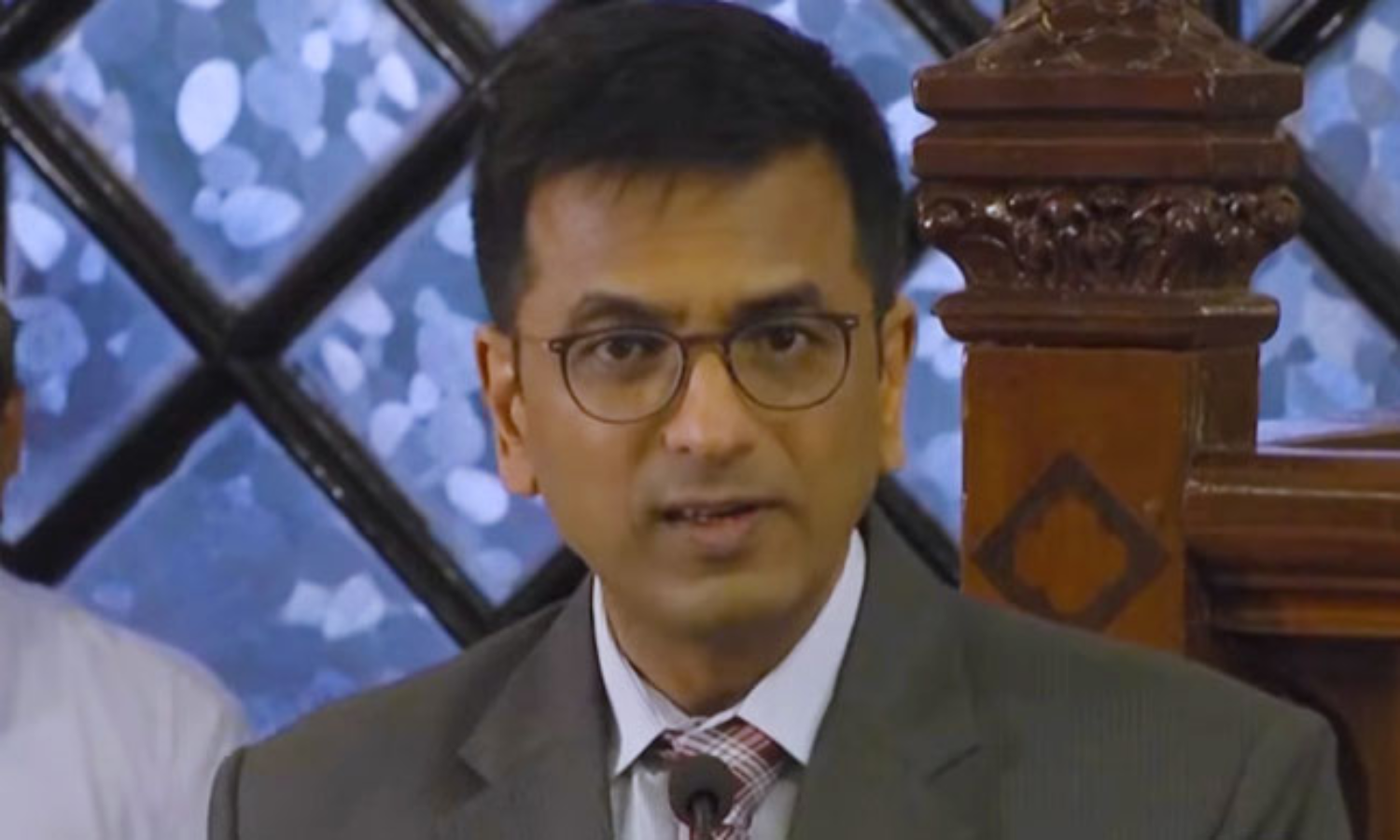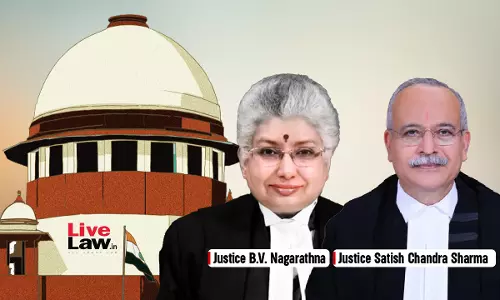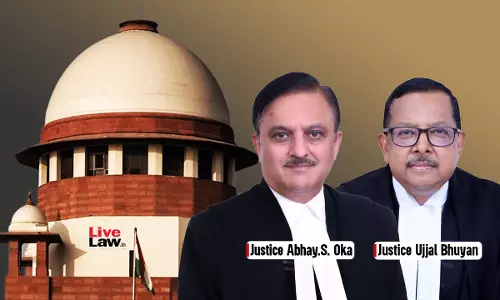Constitution Founders Attempted A Radical Transformation Of Society Which Was Based On Caste & Patriarchy : Justice D Y Chandrachud

On the occasion of the birth centenary of Justice Y V Chandrachud, former Chief Justice of India, the Indian Law Society, ILS Law College, the late former Chief Justice's alma mater, organized a celebration as well as a discussion on the topic "A Changing Society and Constitutional Continuity – Experience in Pursuit of Justice"."Looking back at the life of my Father, we are separated in...
On the occasion of the birth centenary of Justice Y V Chandrachud, former Chief Justice of India, the Indian Law Society, ILS Law College, the late former Chief Justice's alma mater, organized a celebration as well as a discussion on the topic "A Changing Society and Constitutional Continuity – Experience in Pursuit of Justice".
"Looking back at the life of my Father, we are separated in time, but we are united in the Constitutional framework that we have both vowed to uphold", remarked Dr. Justice DY Chandrachud, Judge of the Supreme Court of India, at the session.
The event was attended by Supreme Court Justices DY Chandrachud and Rohinton Fali Nariman, with emotionally awakening reminiscence speeches delivered by the grandsons of Chief Justice YV Chandrachud, Dr. Abhinav Chandrachud, Advocate at Bombay High Court, and Dr. Chintan Chandrachud, Associate at London Office of QEUS LLP.
The discussion on the topic commenced with Justice Chandrachud stating:
"Our Constitution was framed in a world which was starkly different from our own, but it continues to be the highest authority in the source of guidance for interpreting our laws. How then does a 70-year-old document remain relevant to face the challenges, the changing moods and aspirations of the people of the 21st Century?"
Justice Chandrachud remarked that despite the changes that had taken place over the decades over constant dialogues between the governments of the day, the people and the judiciary, the underlying structure of the Constitution has remained unaffected.
Chief Justice YV Chandrachud's prescient opinion in the case of Minerva Mills Ltd. v. Union of India (1980) was highlighted which said, "Amend as you may even the solemn document which the founding Fathers have committed to your care for you know best the needs of your generation, but the Constitution is a precious heritage, therefore you cannot destroy its identity."
Justice Chandrachud then commented upon the roots of our democratic society, which stemmed from colonialism, against all odds.
"All political expression and contestations through democratic means are often enabled by the Constitution of democratic societies. The Indian Constitution is reflective of a century-long struggle for self-determination. The Constitution embodied a transformative vision at its birth. The founders attempted a radical transformation of a society which was based on caste and patriarchy, where liberty lay at the command of a colonial master."
In this context, Justice Chandrachud invoked historian and writer William Dalrymple's The Anarchy wherein it had been remarked that the East India Company's conquest of India remained the supreme act of corporate violence in world history. For all the power wielded today by the world corporations, they were tame beasts compared to the ravaging territorial appetites of the Company.
Working against the essentiality of what surrounds a democratic society, the social vision of the Indian Constitution was termed as "revolutionary" by Justice Chandrachud. However, the political vision was based on the orderly transition governed by the rule of law. Members of the Constituent Assembly were inspired by the Fabian society and a socially-inspired welfare state.
"However, it was recognized that economic policies should be a product of democratic policies and could not be enforced for posterity."
Justice Chandrachud then stated that a measure of a Constitution could only be achieved by discerning how well it had managed the balance between entrenchment and change.
"In the 70 years since the adoption of the Constitution, it has seen over 100 amendments to its form. Some of these amendments such as the Fundamental Right to Property and the introduction of the Anti-Defection Tenth Schedule have redistributed fundamentally the economic and political power around social actors. The judiciary has also taken effective steps to adapt to the changing needs of society, such as striking down of many colonial-era laws."
Justice Chandrachud went on to refer to Chief Justice YV Chandrachud's endeavor to provide an avenue for Constitutional justice in the sphere of criminal law.
"Justice YV Chandrachud in his tenure sought to give voice to Constitutional justice in an area that was close to his heart: criminal law. His compassionate persona was reflected in the scrutiny of evidence to unearth the faultline of society which translated to excesses in law. For instance, he acquitted a person who had been convicted of murder and was sentenced to death by finding that he had been falsely accused of rape and murder."
With this insight into the multiple facets of law and its intersection with society, the judgment delivered by Justice YV Chandrachud served as a guiding light for reformative and not only penological aim of criminal law.
"Section 303 of the Indian Penal Code mandated a death sentence when murder was committed by someone undergoing life imprisonment. While invalidating the provision, Chief Justice YV Chandrachud sought to probe the psyche of a prisoner who often operates exceptional circumstances that are unlikely to recur. He said that for the sentencing procedure to be just, fair and reasonable under Article 21, the Court should consider mitigating factors and observe the reality of prisons."
In light of the above, Justice Chandrachud delved into a discussion regarding the two biggest challenges faced by independent India: discrimination and poverty.
While dealing with the aspect of "discrimination", Justice Chandrachud shed a light on how "universal franchise" was a revolutionary concept in Indian democracy as the right had been recently extended to women, people of colour in supposed mature societies.
"However, the drafters of our Constitution were cognizant that political equality would not be enough to weed out the inequality that exists in the social and economic spheres in our society."
Noting that Indian society still remained deeply hierarchical, Justice Chandrachud referred to KG Kannabiran and Kalpana Kannabiran who had stated that the Constitution was often invoked to give voice to counter hegemonic imaginations of justice rooted in the resistance movements and argumentative traditions that have blossomed in the regions at different points of history.
Justice Chandrachud then enlightens the audience of the issue of how the founders of the Constitution were not always of one mind.
"The ratification of the Constitution was a task fraught with difficulties. This divergence between the Founding Framers may explain why every part of our Constitution does not always speak with one voice. It accommodates disparate and often conflicting stands. Constitutional outcomes are not preordained in the scriptural traditions. Their uncertainty arises due to the need to accommodate the divergence and duality."
Article 15(1) provides that the State shall not discriminate on the grounds of caste, sex, religion, place of birth, and the Indian Supreme Court adopted a formalistic reasoning of the same, said Justice Chandrachud.
"In Air India v. Nargesh Mirza (1981), the Air Hostess case, the Supreme Court held that Articles 15(1) and 16(2) only prohibited those acts which discriminated on the grounds of sex. When coupled with other considerations, it was allowed. But, other considerations sometimes are premised on factors such as differences between men and women, such as physical character, maternal functions or competency. The predominant liberal feminist thought of the time was concerned with achieving formal equality."
Invoking feminist scholar Mary Wollstonecraft's statement that the mind has no gender, Justice Chandrachud remarked that judicial proceedings have often held that women and men have natural differences with women being the "weaker sex" and in need of protection. However, this notion fails to consider how socio-economic and educational inequalities have disadvantaged women, thereby producing the apparent differences.
"The Second Wave of feminism arising around 1960s gave rise to radical feminist thought which argued that the structural disadvantages that women face must be eliminated to achieve substantive equality. This scrutinizes whether the statute contributes or reinforces the social, cultural and political subordination of women."
Justice Chandrachud, on Article 15, said that a structural reading of the same struck down the idea of natural differences between men and women as it identified discrimination as an outcome of social, economic and cultural structures of society which create a system of exclusion.
Referring to the cases of Babita Puniya and Annie Nagaraja, concerning the grant of Permanent Commission to women in the Army and Navy respectively, Justice Chandrachud brought up the submissions of the Union of the India which stated that women had not been granted Permanent Commission due to inherent dangers involved in serving in the Armed Forces.
"These inherent dangers revolve around privacy, maternity issues and child care. In Annie Nagaraja, the Union argued in a similar vein that sea duties are ill-suited for women due to lack of separate bathrooms and inability to return to base. I noted in the judgements that underlying the submissions of the Union is the strong stereotype that owing to the physiological differences between men and women, women as the weaker sex will not be able to undertake certain arduous duties."
Justice Chandrachud castigated the submissions as they revolved around the notions of the duties of women being located in marriage and child care, thereby being based on stereotypes that domestic responsibilities solely lie with a woman. Such discrimination on the basis of outdated ideas of physiological differences are indistinguishable from the prohibition on discrimination on the grounds of sex enumerated in Article 15.
As Justice Ruth Bader Ginsburg of the US Supreme Court noted, "The pedestal you put women on, is a cage." In this context, Justice Chandrachud was pleased to note that the school of radical feminist thought had nudged the State to actively adopt progressive laws for the betterment of women, such as the Domestic Violence Act, 2005, and provisions in the Indian Penal Code pertaining to cruelty against women. Additionally, the Prevention of Sexual Harassment at the Workplace was an example of corrective legislation, meant to further gender equality in Indian society.
"We have also expanded the definition of violence by including emotional, physical and sexual violence in the same. The DV Act has further evolved to include women in live-in relationships, mothers and daughters. We have also evolved to include intersectionality. The interaction of multiple social identities can produce a unique experience of marginalisation".
A 2018 United Nations Report was referred to by Justice Chandrachud to highlight that the life expectancy of Scheduled Caste women is 14.6 years lower than for women from a higher caste.
"A Scheduled Caste woman experiences both deprivation on account of gender and caste. Shah Bano's case exemplifies how intersectional discrimination works. Despite a later legislation trying its best to overturn the verdict in the case, the Supreme Court ensured that Muslim Women were entitled to maintenance under Section 125 of the Code of Criminal Procedure."
Speaking on the aspect of poverty in India, Justice Chandrachud stated that at times poverty in India was a consequence of identity. The Constitution's intention for caste in India was a critical tool for interpreting policies for affirmative action. The Fundamental Right against discrimination on the grounds of sex had been harmonized with securing the right to work in the Vishaka v. State of Rajasthan case.
"73 years after Independence, the Constitution has endured both peace and strain. We have reinvented ideas of political freedom after severe suppression of the Emergency era. Those who are knocking on the doors of the Supreme Court for inclusion, we cannot make them wait while their fellow humans enjoy their rights. Their frustration can be summarized by quoting James Baldwin, 'How much time do you want for your progress?'"
Justice Chandrachud also opined about the preoccupation with the notion of a Judge and his judgement, stating that the same failed to take into consideration the important question of what the Constitution meant to people at a particular point of time. He encouraged the engagement of people with the Constitution in the courtroom and beyond; through people's movements, news reports, editorials and academic texts expressing their vision of the Constitution.
He ended the discussion on the note that "Our Constitution is a tool to achieve the continual social, political and economic emancipation of all citizens. But, it is a platform for social coordination among competing factors within a pluralist society. It is this that leads to both continuity and change."




